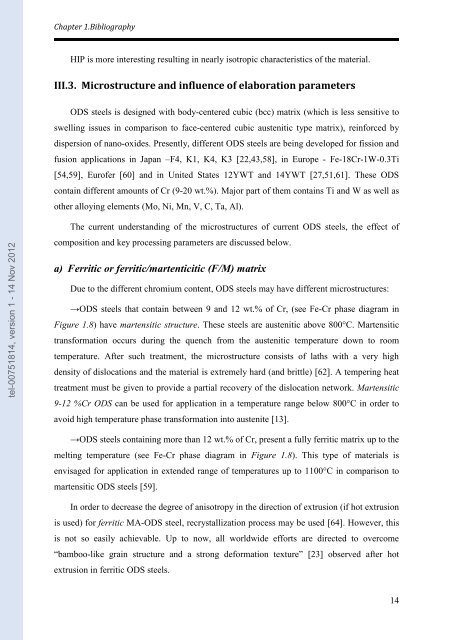Etude par Sonde Atomique Tomographique de la formation de nano ...
Etude par Sonde Atomique Tomographique de la formation de nano ...
Etude par Sonde Atomique Tomographique de la formation de nano ...
Create successful ePaper yourself
Turn your PDF publications into a flip-book with our unique Google optimized e-Paper software.
tel-00751814, version 1 - 14 Nov 2012<br />
Chapter 1.Bibliography<br />
HIP is more interesting resulting in nearly isotropic characteristics of the material.<br />
III.3. Microstructure and influence of e<strong>la</strong>boration <strong>par</strong>ameters<br />
ODS steels is <strong>de</strong>signed with body-centered cubic (bcc) matrix (which is less sensitive to<br />
swelling issues in com<strong>par</strong>ison to face-centered cubic austenitic type matrix), reinforced by<br />
dispersion of <strong>nano</strong>-oxi<strong>de</strong>s. Presently, different ODS steels are being <strong>de</strong>veloped for fission and<br />
fusion applications in Japan –F4, K1, K4, K3 [22,43,58], in Europe - Fe-18Cr-1W-0.3Ti<br />
[54,59], Eurofer [60] and in United States 12YWT and 14YWT [27,51,61]. These ODS<br />
contain different amounts of Cr (9-20 wt.%). Major <strong>par</strong>t of them contains Ti and W as well as<br />
other alloying elements (Mo, Ni, Mn, V, C, Ta, Al).<br />
The current un<strong>de</strong>rstanding of the microstructures of current ODS steels, the effect of<br />
composition and key processing <strong>par</strong>ameters are discussed below.<br />
a) Ferritic or ferritic/martenticitic (F/M) matrix<br />
Due to the different chromium content, ODS steels may have different microstructures:<br />
→ODS steels that contain between 9 and 12 wt.% of Cr, (see Fe-Cr phase diagram in<br />
Figure 1.8) have martensitic structure. These steels are austenitic above 800°C. Martensitic<br />
trans<strong>formation</strong> occurs during the quench from the austenitic temperature down to room<br />
temperature. After such treatment, the microstructure consists of <strong>la</strong>ths with a very high<br />
<strong>de</strong>nsity of dislocations and the material is extremely hard (and brittle) [62]. A tempering heat<br />
treatment must be given to provi<strong>de</strong> a <strong>par</strong>tial recovery of the dislocation network. Martensitic<br />
9-12 %Cr ODS can be used for application in a temperature range below 800°C in or<strong>de</strong>r to<br />
avoid high temperature phase trans<strong>formation</strong> into austenite [13].<br />
→ODS steels containing more than 12 wt.% of Cr, present a fully ferritic matrix up to the<br />
melting temperature (see Fe-Cr phase diagram in Figure 1.8). This type of materials is<br />
envisaged for application in exten<strong>de</strong>d range of temperatures up to 1100°C in com<strong>par</strong>ison to<br />
martensitic ODS steels [59].<br />
In or<strong>de</strong>r to <strong>de</strong>crease the <strong>de</strong>gree of anisotropy in the direction of extrusion (if hot extrusion<br />
is used) for ferritic MA-ODS steel, recrystallization process may be used [64]. However, this<br />
is not so easily achievable. Up to now, all worldwi<strong>de</strong> efforts are directed to overcome<br />
“bamboo-like grain structure and a strong <strong>de</strong><strong>formation</strong> texture” [23] observed after hot<br />
extrusion in ferritic ODS steels.<br />
14

















